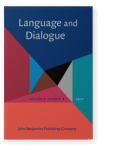Vol. 7:2 (2017) ► pp.213–235
What does ‘emergency’ mean?
Corrections in Romanian and Italian political interviews
This article analyzes political interviews, focusing on the corrections made by the interviewees in their answers, from a comparative perspective. The data included both Romanian and Italian language interviews, published in print and online media. Two criteria for the classification of corrections have been identified, one regarding the target of the correction and one regarding the form in which the correction is made. The results show that content-oriented corrections are the most frequent type in both corpora, while mitigated corrections appeared more often in the Italian corpus than in the Romanian one. The politicians interviewed use corrections in order to reject the interviewer’s stance and to demonstrate a better understanding or knowledge of the topic discussed.
Article outline
- 1.Introduction: Politics and the media, face-to-face
- 2.Data and method
- 3.Interviews and confrontations
- 4.Types of corrections
- 4.1Classification according to the target of the correction
- 4.1.1Context-related corrections
- 4.1.2Content-related corrections
- 4.1.2.1Corrections of IR’s statements
- 4.1.2.2Corrections of a third party’s statements
- 4.1.3Form-related corrections
- 4.1.3.1Term-related corrections
- 4.1.3.2Corrections of grading
- 4.2.Classification according to the form of the correction
- 4.2.1Unmitigated (direct) corrections
- 4.2.2Mitigated (indirect) corrections
- 4.1Classification according to the target of the correction
- 5.Distribution of corrections across the two corpora
- 6.The role of corrections in the interaction
- 7.Concluding remarks
-
References
This article is currently available as a sample article.
